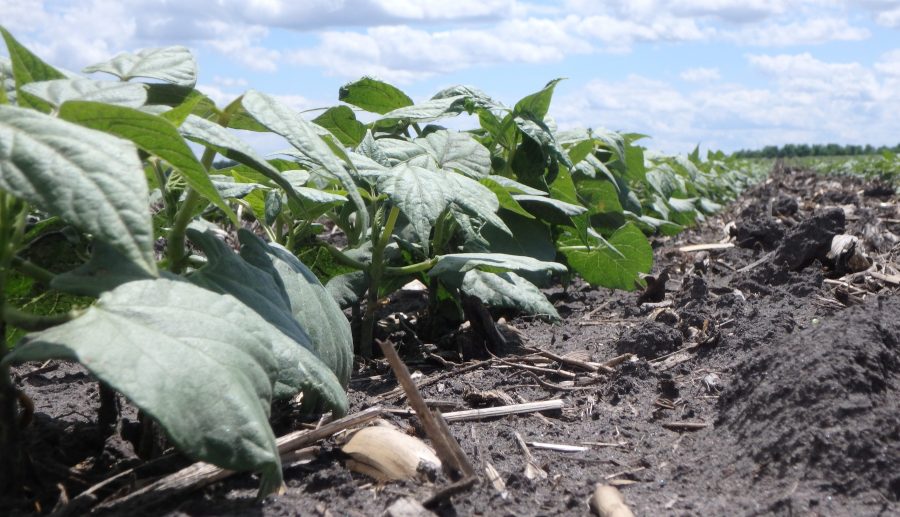May 1 was a beautiful day for seeding soybeans and was the start of #plant17 for many farmers across the province. My research crew hit the field in late April – soil sampling, cultivating and flagging to set up our research plots in Carman. The first experiment to be seeded was Soybean Seeding Windows where we will plant soybeans within four generalized seeding windows to further refine seeding date recommendations.
Rewind and it’s hard to believe six months ago I was wrapping up files at MPSG, sending out my last Bean Report and preparing to begin a new adventure at the University of Manitoba. Coming to the university was a bit of a homecoming you might say, as I completed my undergraduate and graduate work here not too long ago. Returning as an academic rather than a student, and interacting with my colleagues who have been my professors and advisors has been gratifying. I’ve been welcomed by all and look forward to contributing to the faculty.
I came to the university with two things in tow: a laptop and a mission to build an applied agronomy research program focusing on soybeans and pulses. In my interview, I laid out broad objectives for the program and when you get caught up in the excitement of getting to where you’re going, the daily grind becomes busy. Part of the daily grind is navigating all the university policies and procedures, which albeit critical for accountability, can be limiting when flexibility is needed to accommodate diverse programs. There is no one size that fits all. Regardless, my first priorities were to acquire land, seed, equipment and people. To do this, I connected with my colleagues, industry partners and set things in motion.
Overall the process went nearly flawless – I now have a lab space occupied by two motivated and skilled technicians (Mike and Geertje), trials are going in the ground and when you are reading this, it will be spraying time.
In building this research program and deciding on projects and activities, there are several questions I ask myself:
What agronomy questions are we asking today? Five years from now? Do we have existing knowledge but lack effective technology transfer? How do you design an experiment to address the question while balancing the agronomic, economic and environmental considerations? Where should the experiment be located – does a research station and target audience coincide?
A lot of university field research is conducted at the Ian N. Morrison Research Farm in Carman where field- based programs have land allocations and equipment. It’s like many farms co-existing and sharing resources when it makes sense to do so. My program will have some experiments at Carman, but we will be spread out across the province. Logistically, because we don’t have our own equipment but also strategically to reach different regions and audiences. In 2017, we will have research in Arborg, Beausejour, Carman, Melita, Morden and Portage la Prairie and will expand next year. To facilitate research outside of Carman, I will collaborate with Manitoba Agriculture, AAFC, contract research groups, industry and farmers. Agricultural research has decentralized over the years, in part due to the On-Farm movement, but there is more work that can be done to develop BMPs in each of the major agro-regions of Manitoba.
In addition to public research, the university is a place of teaching and higher education where young farmers and agronomists come to gain knowledge, experience and inspiration. As an agronomist, researcher and farmer, I’m in a unique position to help shape the student experience. I’ve had several opportunities to engage with diploma students and look forward to seeing how this aspect of my position evolves. This summer, I look forward to training a summer student (Lina), as part of our research crew and providing graduate students with the opportunity to participate in field research by assisting with our hail damage trials.
Since it is the first growing season as a new research team and program, I anticipate there will be kinks to work out. It’s like on the farm this year where we have a new seeder and GPS. It took twice as long to seed the first quarter, but after proper calibration and training to understand the new functions, the system will allow us to be more efficient and profitable. This is the same outcome I have for my research to help you as farmers and advisors. You can keep up to date with my program on Twitter (@kristenpodolsky) or catch us at a field tour this summer.
– Kristen MacMillan
Agronomy questions being explored in 2017
- Should we be planting soybeans earlier?
- What is the optimum nitrogen rate for dry beans?
- How does hail damage affect soybean productivity?
- How does stubble type affect dry bean productivity?
- Can we plant soybeans beyond current seeding deadlines?
- How do fungicide products and timing compare in soybeans?

